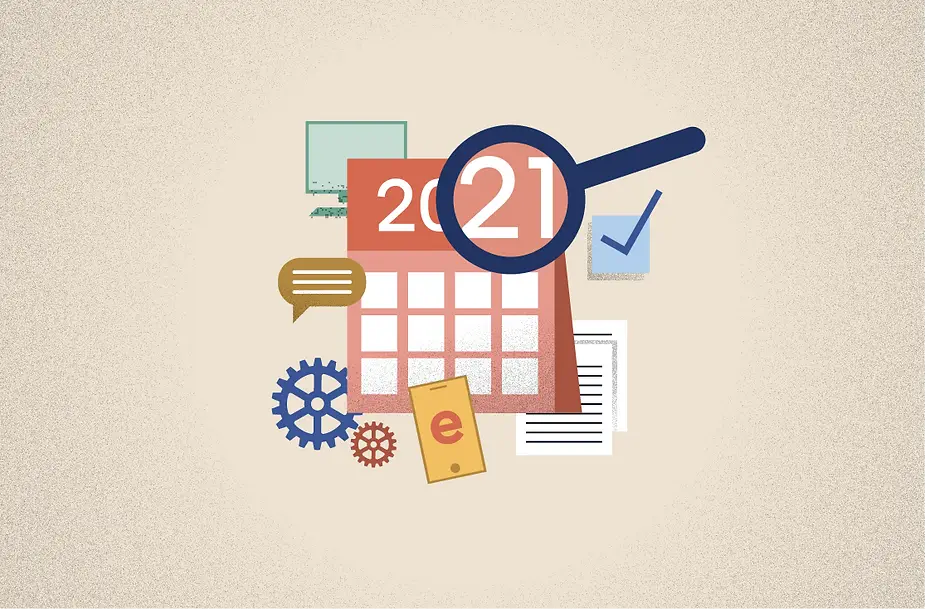Looking ahead, we're taking a few key lessons we learned from our peers, our admins, and our learners.
In many ways, 2021 has felt like an uncanny sequel to 2020. With the pandemic still soaring, many workplaces have had to put remote and hybrid solutions in place, which were keenly felt by People Ops and Compliance teams.
At Ethena, we’ve been lucky enough to partner with some of the biggest innovators in tech, and over the past year, via our conversations with admins and feedback from employees (by the way, Ethena reached 500,000 pieces of learner feedback this year!), we’ve had a front row seat to some major shifts in the industry. Looking forward to 2022, we’re reflecting on some of the biggest lessons we’ve taken away in the past year.
Going remote hasn’t reduced harassment
Since Spring of 2020, many of us have had to adjust as the pandemic forced many companies to go remote. Unfortunately, something that hasn’t changed is the amount of harassment in the workplace, manifesting now in the virtual office rather than the live one. Gender-based harassment is still severe and pervasive, and according to a Project Include report, it may have increased in the online environment:
More than a quarter of respondents said they experienced gender-based harassment more often or much more often since Covid-19, and almost all (98%) of those respondents self-identified as women, or as genderqueer or nonbinary people.
Harassment clearly wasn’t left behind when we left the office; it’s found a new home in Slack channels and Zoom calls. It’s important for harassment prevention and compliance programs to keep up with the times and adapt as circumstances change. Employees should see the current state of the world reflected back to them in their training and find the material relevant to what their day-to-day looks like. For example, when the pandemic first started, Ethena added the topic of “Online Harassment” to our Harassment Prevention course.
Workplace harassment is broader than just sex or gender
Although sex and gender identity are significant factors in recent harassment metrics (women, genderqueer people, or nonbinary people were 40 times as likely on average to have experienced an increase in gender-based harassment than white men since the start of the pandemic, according to the same Project Include report), a much broader group of workplace harassment took place in 2021. A recent AllVoices poll noted that of the 44% of people who experienced harassment in the past year, the top four types of harassment reported were “Personal harassment/in-person bullying” (48.6%), “Discriminatory harassment/bias” (43.3%), “Online harassment/cyber bullying” (40.6%), and even “Physical harassment” (39.4%).
Many employees don’t trust their company to do the right thing
In any workplace, harassment is bound to occur eventually, but it seems that employees are less comfortable trusting their employers with reports of harassment than ever. In the same AllVoices poll, 52% of employees don’t feel psychologically safe at work, narrowing the options for dealing with harassment and resulting in an altogether grim workplace experience.
We can attribute this to a handful of factors, but what stands out is a lack of clear policy–and ethics–from many US companies. Only 21% of US employees say they are working in a company with a strong ethical culture, and globally, that percentage is even lower at 14%. In a year where many employees worked entirely remotely, this lack of communication on company ethics and policy only made a hazardous company culture that much worse:
The lack of clear policies has exacerbated problematic workplace interactions. Over 40% of respondents said their companies had not provided updated or new clear guidelines on appropriate and expected behavior in online communications and around communicating across remote workplaces since Covid-19. –Project Include
Rather than increasing communication on ethics, or even practical things, such as how to report online harassment in the remote office, left many employees feeling lost, ignored, and ultimately distrustful of their employer.
And this distrust has serious implications. This year, “almost a third of UK office workers (31%) and almost two in five (37%) US office workers believed their organization would brush aside at least one form of workplace misconduct,” according to Vault’s “Trust Gap” report. The perception of employer retaliation after misconduct reports rose to a record high of 79% in the US, a “significant increase from what it was in 2017 (44%), and the global trend wasn’t much better” according to the Ethics & Compliance Initiative.
In workplaces where employees don’t trust their company to do the right thing, the results are alarming. Pressure on employees to cut corners or compromise standards reached its highest level since 2000 this year. For culture-conscious companies, it’s up to leaders to set the standards. In 2022, we encourage managers, admins, and executives to lead by example.
Remote work has led to an increase in whistle-blowing
While it’s unclear if working remotely makes people feel more comfortable engaging in unethical behavior with regards to bribery (we know it does for harassment), we do know people feel much more comfortable whistle-blowing instances of bribery or corruption when they do happen. Removed from the office environment, employees are more likely to record a Zoom call, especially when they don’t have a manager looking over their shoulder. According to global law firm Cooley LLP, companies that can expect whistleblower complaints should prepare for them as soon as possible:
All companies – even those that have not yet received whistleblower complaints – would benefit from conducting an internal review of their whistleblowing procedures and internal investigation capabilities to ensure they are appropriate for the size of the company and in line with current standards set by regulators. This will help the company be ready to respond appropriately if and when whistleblower complaints arise.
The first step is making sure that your teams are more conscious of whistleblowers while providing clear instructions on how to file complaints. Whistleblowing is expected to rise from here, so it’s also important to make sure you have current and robust company guidelines for how to handle complaints when they do arise.
(By the way, companies looking for a convenient way to keep anti-bribery law top-of-mind for their teams can check out Ethena’s Anti-Bribery & Corruption course, which was released in October of this year.)
Compliance training as it is right now is . . . not working
Let’s start with the basics. Recent Gallup data shows that fewer than one in four employees (23%) who have participated in a compliance or ethics training session within the past 12 months would rate that training as "excellent." It’s no surprise that compliance and ethics training has a history of being incredibly dull. (Fun–and deeply unethical–fact: we’ve heard of companies where engineers have written code to speed through their sexual harssment prevention training, that’s how much they hate it.) Does it matter that employees hate their training? YES! According to the same data, “those who rate their training as less than excellent do not feel as confident in reporting concerns about unethical behavior.”
On the other hand, investing in relevant and engaging training leads to better and more consistent behavior from employees who witness harassment. In a recent cohort analysis for Ethena learners, we saw a 45% increase in confidence intervening before and after employees took our initial Harassment Prevention training. After training with Ethena, 67% of our learners feel “very” or “extremely confident” intervening on behalf of a colleague experiencing harassment.
As studies continue to show that bad training results in bad outcomes, we’re confident that effective training can result in meaningful learning, practical application, and positive behavioral change.
COVID-19 accelerated the need for effective, flexible training
Many companies looking to find innovative and flexible training solutions for their growing teams long before the pandemic, and throughout the pandemic, the need for training that works for a variety home, hybrid, or virtual offices became a greater priority. Rather than pulling from the same in-office options for things like compliance training, employers are looking for new training content and technology that reflect the actual experiences (and attention spans) of their employees today. Because the consequences of training poorly are dire, for the employee . . . and the company’s reputation and bottom line:
The biggest insight we uncovered is that employees who receive poor training are indistinguishable from those who have had no training at all. Bad training is a waste of time and money. Ethics and compliance officers need to be aiming for that "5" experience -- a compelling, inspiring, engaging educational program that employees can take back to their role and apply. –Gallup Workplace
Working through a global pandemic has highlighted an important lesson for employers: training needs to move with the times. Forcing employees to sit through a two-hour slideshow via Zoom when the large majority of the workday is spent on video calls is likely going to feel tone-deaf and obligatory, rather than useful. Five-minute training sessions that employees can complete on their own time? Now that sounds doable (and familiar ????).
At Ethena, we’re proud to say we created our innovative, effective training method that was not only created with adult learning best practices and modern attention spans, but also with hybrid and remote teams in mind. If you’re interested in reading more on our approach, check out our CEO Roxanne Petraeus’ interview on the Founder’s Field Guide podcast.








